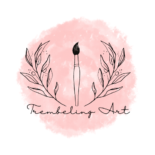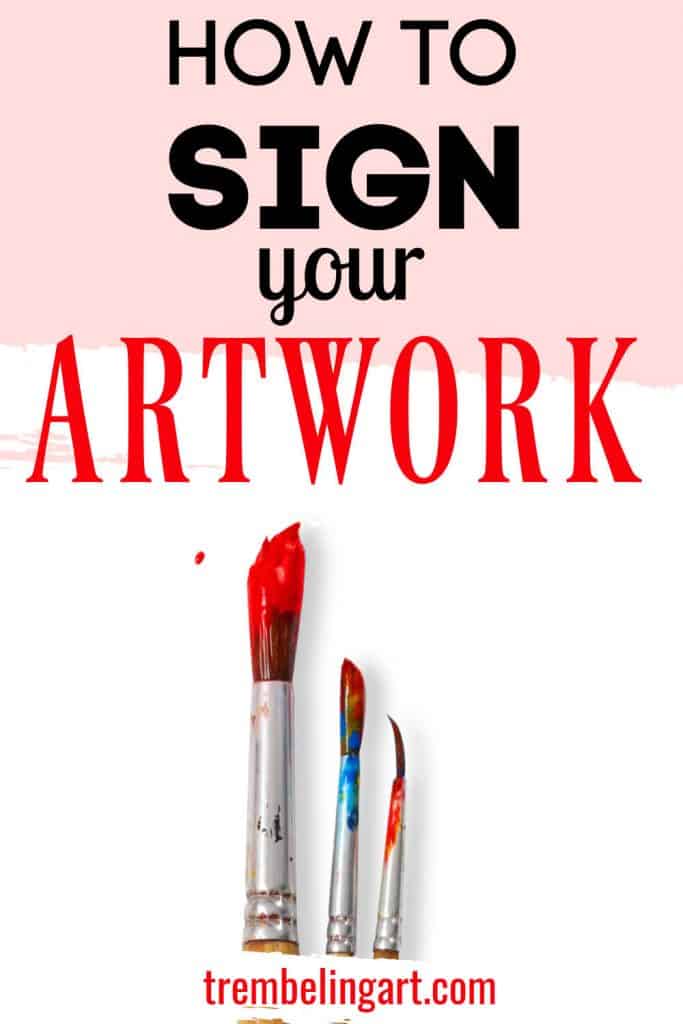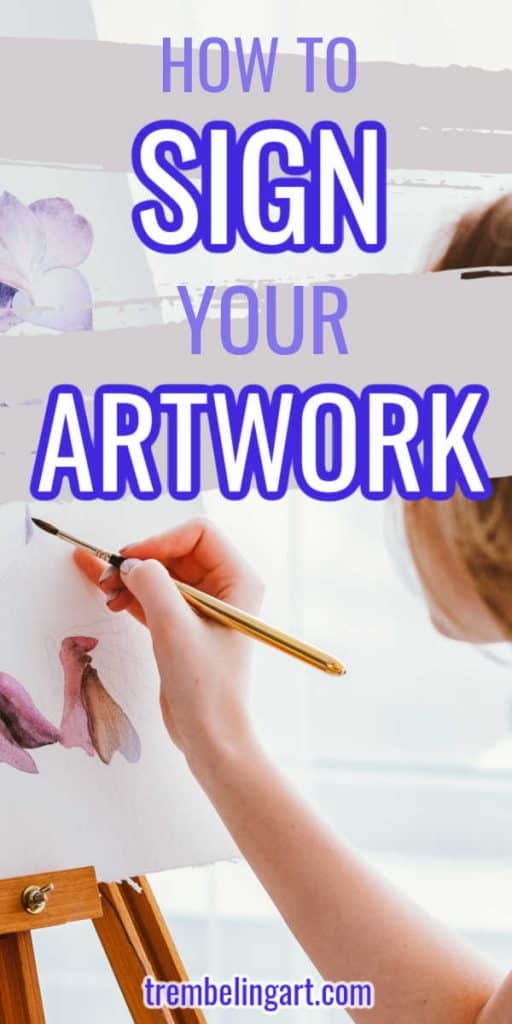One of the most difficult tasks for a beginning artist is deciding how to sign your artwork. Signing your artwork can often lead to some anxiety.
Is my work good enough to sign? Where do I sign? What do I use to sign my work? Do I only sign if I am a professional artist selling my work in galleries?
The simple answer is that you should sign your first painting or piece of art and continue from there. Below, I have offered some tips and techniques for various methods of signing your work.
Your signature is your brand, your mark of ownership. It identifies your artistic work as your own original.
It doesn’t matter if it will be sold or hidden away in a closet; it deserves to be identified as your original piece.
**This page may contain affiliate links to products I have used or recommend. If you purchase something from this page, I may receive a small percentage of the sale at no extra cost to you. For more information click here.**
Where To Sign Your Painting
Where you sign your artwork is often a personal preference. Some artists sign on the front.
Others prefer to sign on the back to not interfere with the piece’s aesthetic. Some artists don’t sign their work at all.
Traditionally, the signature is placed in the lower left corner of the front of the work. This is where a collector or buyer will look first for the signature.
Some artists incorporate their signature into the painting, hiding it in a bush or tree so it doesn’t interfere with the painting.
Where to sign often depends on the subject matter and type of work.
If you are unsure where to place your signature, sign a piece of transparent paper, such as tracing paper. Use this to place over various areas of your artwork to give you some ideas about placement and size.
There is no hard and fast rule as long as the signature doesn’t detract from the painting.
People have asked me if they should sign their paintings before making prints, and sometimes a buyer will request that you not sign your work. I always sign! And I always sign before making prints.
Your signature is part of your artwork, and your painting should never be anonymous. A signature will help deter theft, give you proper attribution, and promote your name as an artist.
Two Important Points to Remember!
1. Sign before you varnish your painting. The varnish will protect your signature as well as the painting. See my post on varnishing your painting.
2. Make allowances for matting and framing. You don’t want your signature hidden behind a mat.
What Do You Use To Sign Your Artwork?
Sign your artwork using whatever medium you used in your piece. For example, an acrylic painting can be signed with thinned paint and a script liner brush.
For a graphite drawing, use a graphite pencil.
It is not always possible or desirable to use the same medium. There are other things you can use to sign your work.
Sakura Pigma Micron pen is a good choice. It has a fine tip, is archival, and is acid-free. It is also available in various colors.
A paint pen such as the Montana Acrylic Paint marker is also a good choice. The Pentel Sign Pen is also good for signing your work.
For oil paintings, many artists scratch their signature into the wet paint with the end of a small brush or a stylus.
This works best with a dry ground layer underneath the wet paint.
If you are concerned about your signature smudging when you varnish your painting, you can lightly spray it with a spray varnish, depending on your medium. In most cases, it isn’t a problem, but you can always test on a piece of scrap paper or canvas.
Whatever you use, ensure it is archival so your signature doesn’t fade over time.

How to Write Your Signature
Some people have beautiful handwriting that translates well to a signature on their artwork. Other people, not so much.
I have Parkinson’s, so my signature is very hit or miss, depending on how bad my tremors are at the time. However, some workarounds can get you a pretty good signature every time.
First, you must decide what you want to use for your signature. You can use your full name, initials, first initial and last name, or even your logo.
I use my first name and last initial, MarilynO. Whatever you choose to use, make sure it is legible.
You can check out some fonts online if you want to use a specific style in your signature. There are a lot of sites with free fonts you can download and keep for future use.
1001 Fonts is a good place to start. Find a font you like and practice writing your name with it.
You can also print out your name using a font you like and transfer it to your artwork using transfer paper. Then, go over it with your paint or archival pen.
I first sign my acrylic paintings with a watercolor pencil. Then I go over them with my paint or pen.
It works well because the pencil is water-soluble, can be removed with water, and redone until you are satisfied.
If you want to have your signature on a nice straight line, use a ruler and a piece of chalk or watercolor pencil to draw a straight line. Then, you can sign your work on the line and rub the line out afterward.

Signature on the Back of Your Artwork
You can also sign the back of your work. The back is also a good place to add the title, date, medium used, and any other information about the piece.
You can add the subject’s name if it is a portrait, where the scene is if you are doing a landscape, or where the inspiration for the piece came from. This is all nice to have for future reference.
Where to Sign Your Art Prints
Prints are usually signed on the border of the print in pencil or ink. If it is a limited edition print, the number of the print is also included.
For example, 1/25 means print number 1 of 25.
Some artists sign the back of the print, and some don’t. Sometimes, the buyer requests that you sign your print in a certain area.

Signing Sketchbooks
You should also sign and date sketches in your sketchbooks. This information might be valuable later in your art journey.
Going back through your old sketchbooks can help you see how far your artwork has progressed and where you got your inspiration for particular pieces.
You never know if these sketches will be sold someday. For more information about sketchbooks, read my post on how to start one.
However you decide to sign your artwork, be consistent.
Over time, your signature becomes part of your brand and is easily identifiable. It is an extension of your artwork and the finishing touch on your painting.
If you have an interesting way of signing your art or have any other ideas or questions, please share them in the comments below.
Don’t forget to check out our free Facebook group, Trembeling Art Creative Corner, for more tips and meet some wonderful artists, from beginners to professionals. A great place to show off your artwork and get your questions answered. 😊
Thanks for reading.








This is the best and most thorough explanation of how to sign a painting that I have ever read. Thank you so much.
Dawna
Hello. I am an amateur artist. I have never sold my works but would consider it if the opportunity came along. I am getting into the habit of signing my work but am unsure what name to choose.
Do artists tend to use a proper first name or a casual name when signing their work? For example, William vs. Bill.
Hi Elizabeth; What signature to use is a personal preference. Some artists prefer the formal signature complete with full first and last name. Some artist take a more casual approach and use the short form of their name. Artists also might use just their initials. I use my first name and last initial because my name is rather long. Other artists have been known to use a nickname or a name they are commonly referred by. It is really your own personal preference so you should go with whatever feels comfortable to you. I am glad you are contemplating selling your work. 😊
Loved this article. My signature is horrible. I was thinking about getting a custom made signature stamp. I work with oils and thought it might be too thick to get a clear impression. I never thought of letting my art work dry first. I just need to decide how I want my signature done.
Thank you Adele 😊. A lot of people do a custom stamp for signing their artwork. Tracing paper is a great tool for deciding how to sign. Do several different signatures on the tracing paper and hold them up to your painting to see which style you like best. 😊
I also have hand tremors and find it a challenge to discover a type of art or subject matter I can be satisfied to attempt. Do you have any suggestions?
Hi Stephanie. It really depends on how bad the tremors are. At first I was able to do detailed paintings. Now I have had to learn to be happy with a looser,more painterly style and abstract work. I do find paint pens easier to control than a brush these days. I also am comfortable with drawing using graphite, charcoal and colored pencils. I hope this helps to give you some ideas.😊